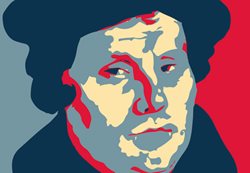The 31st October 1517 saw Martin Luther nail his 95 Theses to the door of the Castle Church in Wittenberg. As we continue to look at his life and legacy, it is actually a common misconception that this was a defiant act of protest by him and that his theses represented inflammatory anti-Catholic statements.
In fact, the church door acted as the university noticeboard. Debates on theses were common and they were posted in Latin and therefore only intelligible to a minority of people. Certainly Luther’s main concern was to have an academic debate on the subject
of indulgences. These were the traditional church certificates which, upon reception of a suitable fee, were claimed to secure a reduction of servitude in purgatory for relatives of the contributor.
His motivation was also primarily pastoral, as several members of the local congregation dismissed his appeal for the necessity of personal faith in Christ and declared their faith in the indulgence system.
Break with Rome
 It was the widespread publication of Luther’s theses in German within a couple of weeks that lit the blue touch paper of the European Reformation. Remarkably, Martin Luther survived several potentially fatal trials and lived to the age of 62, dying of natural causes.
It was the widespread publication of Luther’s theses in German within a couple of weeks that lit the blue touch paper of the European Reformation. Remarkably, Martin Luther survived several potentially fatal trials and lived to the age of 62, dying of natural causes.
Successive trials by his own Augustinian Order and other constraints: a papal bull of excommunication from the Pope
Leo X and examination before the Holy Roman
Emperor Charles V all failed to silence him. Undoubtedly, he was protected by
the powerful Frederick III, ruler
of Saxony and founder and benefactor
of Wittenberg University, in which Luther was now the star attraction.
The break with Rome was not instantaneous. Luther’s personal journey started from a position where he initially believed that the pope would rectify Church error and abuses if he was aware of the real situation, to a position where he believed the pope was too much a part of the problem to ever be part of a solution.
Sola scriptura
One of the fundamental building blocks of Luther’s new learning was that Scripture alone (sola scriptura in Latin) should be the source for all that
we believe and practice. He published a German translation of the New Testament in September 1522 and it went through 87 editions before he completed the entire German Bible in 1534.
However, while sola scriptura was a useful sword with which to cut away much of the traditional Church beliefs and practices, it also turned out to be a two-edged sword and caused bitter divisions among supporters of the reformation movement. The assumption that the provision of an open Bible would be enough to accomplish reform proved naive as varying interpretations emerged.
Later life
Luther enjoyed celebrity status for many years and built up a new church, which adopted his name, ‘Lutheran’. Yet he had many troubles, perhaps most notably when, after some hesitation, he supported the aristocracy against the peasants in the 1524-25 Peasants’ Revolt. His popularity in Germany certainly waned significantly after this debacle.
In June 1525 Luther married former nun Katharina von Bora, which was a happy marriage. They had six children and lived in the former Augustinian monastery in Wittenberg, a home for their own family and the children of two of Luther’s sisters. They also looked after student lodgers, paying guests and many visitors who came to converse with the famous Dr. Luther.
The Reformation
Reformation ideas were not immediately adopted within German territories. At
an Imperial Diet in Speyer in 1529 (akin to the parliament of the Holy Roman Empire) a decision was taken to freeze the reform process. Reforms already introduced could be retained, but no further innovation would be permitted. Many recorded a protestatio and the nickname ‘Protestant’ entered common vocabulary.
A prolific hymn writer, music played an important role in his life. His massive literary output ensured his ongoing significance for the reformation movement in Germany and far beyond. However, he did not enjoy robust health and suffered variously from vertigo, tinnitus, a cataract, kidney and bladder stones and angina. His famous short temper and harshness are sometime attributed to his health problems.
Perhaps most controversially, in one of his last publications, On the Jews and their Lies (1543), Luther urged active persecution of Jews in German territories. Unsurprisingly, his views were quoted by the Nazis in support of their own anti-Semitic programmes in the 20th century.
Luther died of heart failure on 18th February 1546 while on a visit to Eisleben, the town of his birth but his ideas gave birth to a network of Lutheran Churches which survive to this day.
 Laurence Kirkpatrick is Professor of Church History at Union Theological College. He studied Ancient History, Semitic Studies and Theology (UTC)at Queen's University (QUB) and Early Church History at the University of Glasgow. He was minister of Muckamore Presbyterian Church for 12 years before his appointment at UTC in 1996. Professor Kirkpatrick is also the chair of the Systematic Theology, Practical Theology, and Church History Subject Board of the Queen’s University Institute of Theology.
Laurence Kirkpatrick is Professor of Church History at Union Theological College. He studied Ancient History, Semitic Studies and Theology (UTC)at Queen's University (QUB) and Early Church History at the University of Glasgow. He was minister of Muckamore Presbyterian Church for 12 years before his appointment at UTC in 1996. Professor Kirkpatrick is also the chair of the Systematic Theology, Practical Theology, and Church History Subject Board of the Queen’s University Institute of Theology.
This blog is based on an article that first appeared in the December 2016 edition of the Presbyterian Herald. You can read part 1 here.
Faith at the Crossroads: This special celebration of the 500th anniversary of the Reformation will take place on 17th/18th/19th October in Dublin/Londonderry/Belfast respectively. For more details visit our events page.